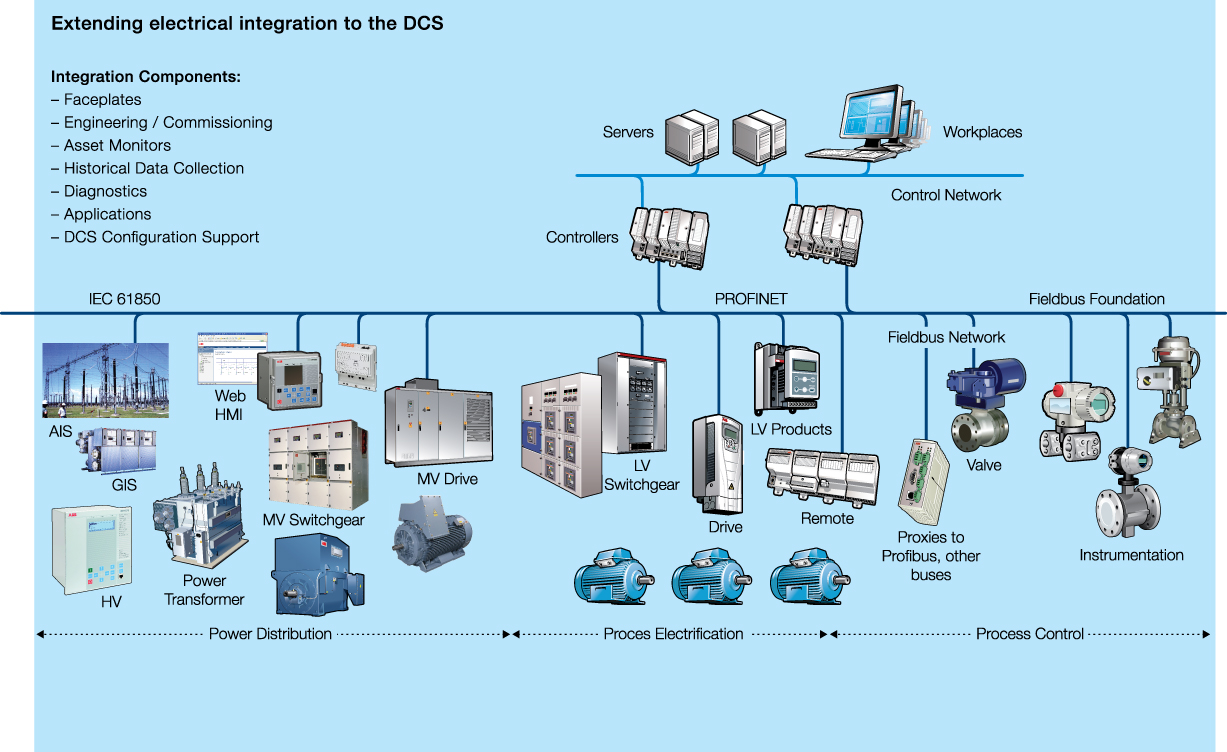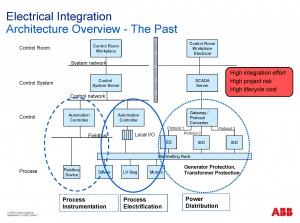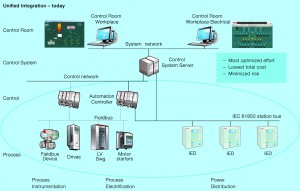October 2009 Vol. 236 No. 10
Features
Integrated Power & Automation Systems: Future Trends For Pipeline System Efficiency

Leaders in the oil and gas industry have continually expressed the need for increased operational efficiency, reduced downtime, reduced energy consumption, and decreased environmental emissions.
To meet these industry needs, a true integration platform is necessary in order to tie together the electrical control system, process control system, and maintenance equipment health information so that managers and operators can make informed decisions on energy and lifecycle management which will increase oil/gas flow uptime.
This article discusses a new system integration architecture and power strategy that addresses each of these issues facing the oil and gas pipeline industry today, as well as future system architecture trends being designed to help alleviate these problems.
Barriers To Meeting Top Needs
Along pipelines and distribution networks, there are major hurdles to efficient operation, including lack of electricity, limited bandwidth for data transfer, and the high cost of network bandwidth. At the product-gathering points, there are organizational barriers among disciplines within the facilities and their suppliers. Typically, there is a lack of communication standards and system architecture designs at all levels within the industry, resulting in higher project execution, commissioning, and lifecycle costs.
Solution: Variable Speed Drives and Electrical Integration
Variable Speed Drives For Energy Efficiency
There are three categories of pipelines: Product-gathering points, transportation pipelines, and distribution networks. Gathering points come together at a terminal station where the product is brought to a common point to be processed, then transported.
It is an energy-intensive process to move oil or gas through a pipeline. Gas needs to be kept at a specific pressure to maintain flow. Compressors are typically used to maintain pressure and over long pipelines, such compressors can be very large and require lots of energy. Often they are driven by gas-powered turbines. Gas turbines, however, are inefficient (only 30% efficiency), environmentally unfriendly, and noisy. They require a great deal of maintenance, resulting in pipeline downtime.
In many situations along oil pipelines, the pumping stations are run inefficiently by operating at full power with flow maintained by control valves. ABB’s solution is Variable Speed Drives (VSDs). VSDs are more energy efficient and require less maintenance than gas turbines, thereby offering more pipeline uptime. VSDs reduce emissions by 50 percent.(1) Moreover, VSDs are typically less expensive than gas turbines. Current trends show pipeline operators replacing their legacy gas turbine systems with VSDs.
Integrated Power & Automation Systems: Electrical Integration Achieves Dramatic Operations Improvements Across All Areas
While VSD technology is the most logical solution for reducing energy consumption and addressing environmental concerns at terminal stations and along the pipeline, a more challenging task is increasing operational efficiency and avoiding downtime at the terminal stations. A unified architecture is required to break down the organizational barriers at both the facility and supplier levels. Open, standardized communications and architectural designs are also needed. ABB’s solution integrates power and process automation systems into a single architecture called Electrical Integration (Fig 1). With Electrical Integration, plant operators can increase operator effectiveness and reduce plant downtime.
(See Figure 1 – Electrical Integration with ABB’s System 800xA: Integrating Process Control, Process Electrification, and Power Management and Distribution)
A terminal station can be equated to a typical process control plant, which can be divided into three areas: Process Control, Process Electrification, and Power Management and Distribution.
- Process Control
Includes instrumentation, safety systems, and controllers. Here these devices communicate using a variety of fieldbus technologies including Profibus, Foundation Fieldbus, and HART. - Process Electrification
Includes low voltage (LV) drives, motors, switchgear, and circuit breakers. These devices typically communicate with the control system via Profibus and ModBus. Profinet is now making its debut into the Process Electrification area. - Power Management and Distribution
Corresponds to Substation Automation (SA) systems. It hosts medium voltage (MV) and high voltage (HV) power equipment including protective relays, also known as Intelligent Electrical Devices (IEDs), transformers, instrument transformers, power meters, drives, and motors.
Challenges Of The Past
Integration of electrical equipment has always been a challenge. There are too many protocols used in SA systems. Some are proprietary while others are open standards. No single protocol has become dominant. As a result, the cost to engineer the SA system is high when multiple vendors supply equipment that uses different communications protocols. The lifecycle costs of a system with a hodgepodge set of communication links are also very high.
In addition, Electrical Integration is not new. It has been done in the past by hard-wiring signals between the electrical equipment and the process control system, as well as by building complex software gateways. Past integration methodologies have high integration costs, high project risks, and high lifecycle costs (Fig. 2).

Figure 2 – Typical Electrical Integration architecture of the past.
Electrical Integration Advantages Of Today
Today we achieve Electrical Integration effectively without high project risk or high lifecycle costs by taking advantage of the IEC 61850 standard. IEC 61850 is an Ethernet-based, global standard for communications and system architecture in substation automation and power distribution systems. It is a global standard for both the IEC and ANSI worlds. IEC 61850 provides a flexible and open architecture. The standard includes:(2)
- Interoperability – allows Intelligent Electrical Devices (IEDs) from different vendors to work together
- Standard data-naming conventions
- Self-describing devices
- Virtualized modeling of logical devices
- Substation Configuration Language (SCL) – common device configuration language
With the Electrical Integration architecture, all devices communicate back to the main control system using their individual protocols (Fig. 3). Electrical Integration bridges two worlds – the instrument and electrical groups now work together as they share a common system. An integrated system provides a unified way to maintain the entire plant. A true integration platform like System 800xA is needed to seamlessly combine the electrical control system, process control system, pipeline-wide data historians, and maintenance equipment health information. This enables personnel to make informed decisions on energy management, lifecycle management, and pipeline uptime on a plant-by-plant, process-by-process, or global basis, as user needs dictate.
System 800xA is used as a common engineering and production interface for process control, electrical, and safety systems. Now the midstream oil/gas industry can take advantage of the integration trend. Since ABB uses the same system framework for both process and electrical control systems, it is simple to implement the Electrical Integration architecture.

Figure 3 – Unified Approach to Automation and Electrical Integration with System 800xA increases productivity and decreases downtime.
Electrical integration with a Distributed Control System (DCS) is best applied at the gas-gathering points in the oil and gas fields and the pipeline end terminal. Here MV and HV power are typically used. Along the pipeline, significantly less power is available so Supervisory Control and Data Acquisition (SCADA) is often a better fit. SCADA is used for wide areas, long pipelines, integrated telecoms, accounting of product flows, and exchange among end users. Variable Speed Drive (VSD) technology applies well to gas-gathering points, transportation pipeline, and end terminals.
Benefits Of Electrical Integration
Electrical Integration provides a wide range of economic benefits including operational efficiency, reduction of downtime, and lower lifecycle costs.
Increased Operational Efficiency
Health of Pipelines and Transportation Centers – Pipelines are monitored 24/7. The technology used to determine key process data such as flow rates and pressure along the pipeline is monitored for inconsistencies, instrumentation health, leak detection, and any other issue that could stop or slow production. Even short stops in production flow can result in large dollar losses.
As a result, pipeline system integrity is the highest priority. Therefore, tying in the electrical system health with the process control system health is critical. With a single view of pipeline system health using Electrical Integration architecture one can determine the overall pipeline system health. Whether the issue is electrical equipment or process control equipment, one can see the health of the overall pipelines with one workstation.
Visibility and Control – Leading industry analyst firm ARC research director Larry O’Brien has stated that increased operational efficiency is all about visibility and control.
“In the HPI [hydrocarbon processing industry], many potential cost-saving opportunities related to power and energy consumption are ignored simply because people in refineries and petrochemical plants don’t have the appropriate visibility or control.” O’Brien further states, “ARC believes that energy savings on the order of 10% can be achieved in many process plants by integrating power and automation.”(3)
With an integrated system, operators will now have visibility into power consumption which will enhance any existing energy usage reduction program. Operators can easily access power usage data and interpret the information. In addition, they will be able to track and trend power consumption which enables the exploration of energy savings opportunities. An increase in power consumption can indicate equipment malfunction and wear. Without visibility into power consumption, no one will know about the equipment malfunction resulting in unexpected downtime plus a preventable increase in energy consumption. Integrate equipment and systems to make energy-efficient decisions.
An integrated system will also provide centralized control. Plant operators can monitor the health of instrumentation, rotating equipment, IT assets, electrical equipment, and energy consumption to determine overall terminal station status. For example, operators will have immediate visibility of any power event such as bus transfer, load sheds, or trips, as well as process control events such as temperature-transmitter failure or calibration-required alert.
The status of critical IT assets can be seen as well, alerting operators to potential system problems. For example, with ABB’s System 800xA, the information will be provided via alarm and events lists as well as e-mail and text-messaging notifications. It can also be sent to a Computerized Maintenance Management System (CMMS). Whether it is an electrical glitch, process control problem, or a failing IT asset, plant operators will have complete visibility and control of the situation.
Collaboration – Make Your Operators Smarter – An integrated system allows your operators to collaborate more effectively with other disciplines. Typically operators make critical decisions in silos. With Electrical Integration architecture operators can now see into the plant beyond their normal process areas.
Systems and equipment have become more complex than ever before. To contribute to industry success today, an operator’s knowledge and skill set must expand beyond traditional roles and functions. A DCS process control operator must now understand the effects that substation automation systems have on the process control areas. Better visibility turns data into actionable knowledge that operators can use to support smart decisions, made more quickly. By utilizing the Electrical Integration architecture, operators get out of their silos and into saving money and increasing uptime throughout the plant.
Reduced Downtime
Reducing downtime with an integrated system is made possible by utilizing an enhanced power-management system to avoid blackouts. A comprehensive power-management system is beneficial to all applications, but it is critical wherever the power system may be unreliable. The system must include mode control, synchronization, active and reactive power control, and load shedding.
An enhanced power-management system is possible with an integrated power and automation system. For example, fast load shedding is possible with IEC 61850 via Generic Object Oriented Substation Event (GOOSE) messaging. Load shedding times are dependent upon system configuration but can be as fast as 40ms. With an integrated system, fast response time for mode control and power control is also made available.
Extended asset management is part of the Electrical Integration architecture. With an integrated plant system, System 800xA is the central point for monitoring critical plant assets well beyond smart instruments. Electrical Integration provides operators and maintenance personnel with current process information along with instrumentation and electrical asset information. It creates a centralized maintenance system that provides maintenance engineers, process control operators, and power engineers with actionable data. ABB has asset monitors for both the electrical and process sides of the plant (Table 1).

Table 1: System 800xA Asset Monitors
Plant managers often view asset management as a business process for smart instruments only. But what about monitoring electric equipment health? According to a study done on a North Sea oil platform, instrumentation accounted for 10.6% of the total maintenance while electrical equipment was 11.3% of the total maintenance. With an integrated system, both instrumentation and electrical equipment health information are made available for the entire plant in a single view for improved monitoring and better decision making. Extended asset management capabilities enable both process and electrical condition-based monitoring to be done with one system.
Problems can be diagnosed more quickly with an integrated system. Traditionally, plant engineers have to visually inspect alarm and events lists from multiple systems, and then try to determine the order of the events that caused a plant upset. The Electrical Integration architecture provides a plant-wide, time-synchronized, common sequence of events list. Plant engineers troubleshoot plant disturbances easily and accurately with such a list. Other advantages to the new architecture are a central point for enterprise resource planning (ERP) and a central data historian for critical data collection.
Another important motivation for implementation of an extended asset management system is the aging workforce. A large percentage of the workforce is heading to retirement and will continue to do so over the next decade. Retirees take with them their critical knowledge of the workings of terminal stations and pipeline systems. Using a plant-wide asset management system, this intellectual property can be captured and retained.
Reduction In Lifecycle Costs
There are many benefits of electrical and process automation integration with the System 800xA. A single view of electrical and process automation systems is provided without additional process system I/O, complex software interfaces, or marshalling racks. Unified operations give plant personnel greater flexibility in controlling the entire facility. They also reduce duplication of equipment, make staff more effective, and lower training costs. With a common platform, end users experience lower maintenance and lifecycle costs, capital cost savings, and efficient engineering by integrated project teams. Typical savings realized by utilizing System 800xA to integrate the electrical control and process control within a plant result in a 20 percent reduction in capital and operational expenditures.
Conclusion
Running pumps along the pipeline at maximum power and maintaining flow with a control valve is no longer the best and most cost-effective course of action. With uncertain future energy costs, leading pipeline operators require energy efficiency. There is a trend to modernize, reduce noise and air pollution, remove high-maintenance, gas-powered engines and turbines, and replace them with electrically driven, quiet, non-polluting motors with variable speed drives.
Multiple industries have employed Electrical Integration as the optimal way to integrate their process, electrical, and maintenance systems. These include power generation, oil refineries and platforms, and chemical plants. Now the pipeline industry can join in on the benefits of Electrical Integration in order to reduce energy costs through better insight to the process areas and equipment that drive energy consumption.
An integrated system allows for an increase in productivity and a decrease of downtime by quickly identifying and reacting to degradation that may lead to process upsets. Asset management that is extended through deployment of condition-based asset monitors for all electrical and process control intelligent devices provides maintenance personnel with visibility and control via a common system to manage all plant assets.
Electrical Integration also decreases investment and operational costs through a reduction of duplicate equipment, more effective deployment of staffing, and lower overall training costs.
Electrical Integration architecture and Variable Speed Drives achieve greater operational efficiency, reduce downtime, and reduce lifecycle costs, thereby setting a trend in the future of the oil and gas pipeline industry.
References
- Oil and Gas Production Handbook, September 2007, Havard Devold
- Technical Overview and Benefits of the IEC 61850 Standard for Substation Automation, Ralph Mackiewicz, SISCO, Inc.
- Hydrocarbon Processing magazine, April 2009, “Reducing cost through an integrated approach to power and automation”, HPI Integration Strategies, Larry O’Brien





Comments